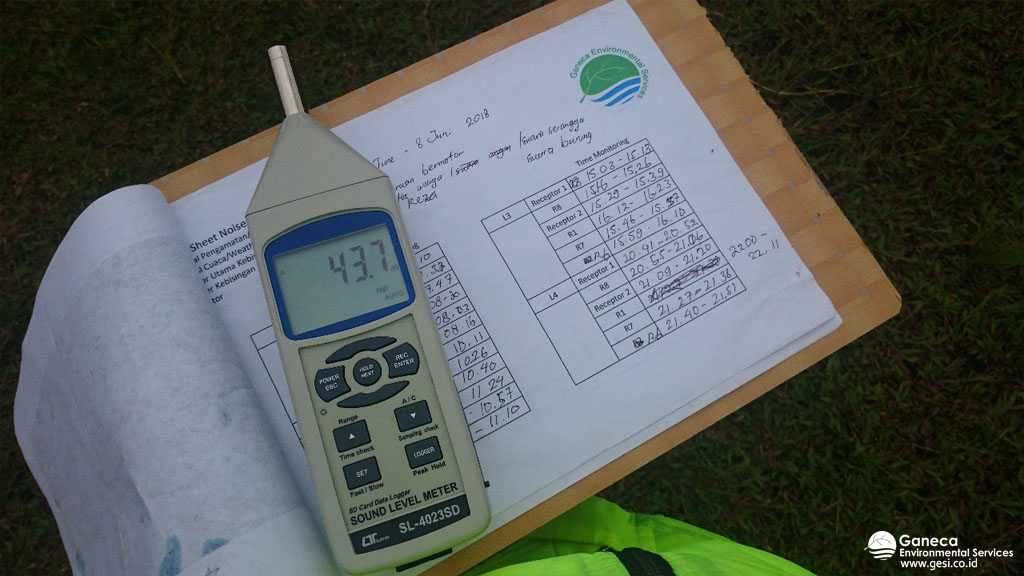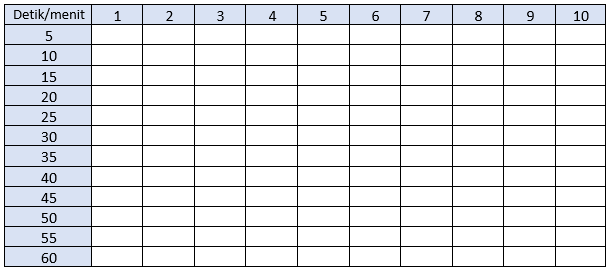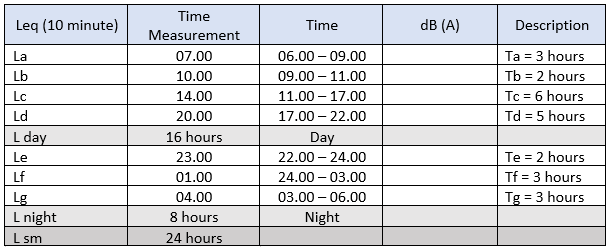
Oleh: Tsabit Walad Al-Wahad, S.T. (GES Environmental Engineer)
Interest in study related environmental economic valuation. Likes every sport activity, culinary, and travelling. He always want to try something new.
High population growth leads to the need for massive infrastructure development. This could potentially cause negative impacts on the environment. If not managed properly, this environmental pollution could potentially have an impact on human health. One type of pollution that can potentially interfere with human health is noise. Noise definition is mentioned in Regulation of the Minister of Manpower and Transmigration No Per.13 /Men/X/2011 Year 2011 on the threshold values of physical factors and chemical factors in the workplace. According to the ministerial regulation, noise is all unwanted sounds sourced from the tools of production process and / or work tools that at some level may cause hearing loss. Therefore, it is necessary to monitor the noise around the construction / work site which could potentially disrupt the health of the workers and the community. The noise monitoring aims to find out how much noise exposure to surrounding environment. So precautionary measure can be done to prevent its potential impact on workers and the community.
Noise levels can be measured using a sound level meter (SLM) device. Sound level meters responds as near as human ear responses. Then, sound level meter gives the measurement result with noise unit, which is deciBel (dB). Sound level meters typically have several sound pressure units divided into A, B and C scales. Measuring noise levels using a scale A sound pressure (db (A)), as it corresponds to normal human ear characteristics. However, before conducting noise measurements, it is mandatory that the sound level meter to be calibrated first.
In addition, according to the Decree of the State Minister for the Environment Number: Kep-48/Menlh/11/1996, the noise sampling is divided into two ways depending on the sound meter level device used:
- The simple way, measuring noise with an ordinary sound level meter, with reading for every 5 seconds for 10 minutes, for a single measurement. Noise measurement in a simple way is conducted with at least done by 2 people. One person sees the time and gives the signal readout every 5 seconds then one other person in charge of reading and recording the results of noise measurements by sound level meter.
- Direct way, the measurement of noise with integrating sound level meter that has data logger capability and LTM5 measurement. LTM5 is the average measurement result every 5 seconds in 10 minutes. The direct noise measurement can be done with only one person because integrating sound level meter does not require reading every 5 seconds. The data of noise measurement is recorded as softcopy, making it easier to analyze the measurement result. Example sound level meter with data logger can be seen in Figure 1.

Then the noise measurement is conducted for 24 hours (LSM), which is divided into day and night activities. The activities during the day are determined for 16 hours (Ls) within 06.00 – 22.00. Then, the night activities determined for 8 hours (Lm) in an interval of 22.00 – 06.00. Each measurement should represent the highest activity at any given time interval by setting at least 4 measuring times during the day and 3 measurement times during the night.
Before conducting noise measurements, it is necessary to map the location of noise sampling first, some things to note include:
- location of source of noise,
- location of measurement of noise source,
- location of noise receptor/receiver,
- location of noise sample measurement in receptor,
- topography between the noise source and the receptor.
Measurement of noise levels is conducted in the open area, and is 3.5 meters from the building wall to avoid sound reflection. The sound level meter height is used between 1.2 – 1.5 meters, corresponding to the average of noise receptor height. Sound level meters require a tripod to reduce the potential of sound reflections by the operator body. The distance from operator to sound level meter is minimum 0.5 meter, with height difference between sound level meter and the operator is minimum 0.5 meter. The microphone at the sound level meter also needs to be directed to the noise source. Measurement of noise level should be done in sunny weather, with not too big wind speed. As a safety, the microphone should always be installed with wind-screen (source: Noise Measurement Manual of Quennsland)

For a single measurement with noise readings for every 5 seconds for 10 minutes, we get 120 noise level data. These data are then inputted into a table to facilitate the analysis of the measurement results. Example noise level measurement results table can be seen in Table 1 below.
Table 1. An example of a noise level measurement table in 10 minutes

After getting the noise level data from the measurement result, then the measurement result analysis is carried out. The result of noise level measurement, calculated to get Leq (24 hours). Leq is the average noise level of the fluctuating noise, with logarithmic equations. First of all we do Leq calculations every 1 minute, by formula:
![]()
After get Leq data for every minute, from the 1st minute (LI) sampai 10rd minute (LX). Then, continue to calculate Leq 10 minute, with this formula:
![]()
And then, Leq 10 minute value that has been obtained fromthe calculation Furthermore, the Leq value of 10 minutes that has been obtained from the calculation is entered into the table according to the time interval represented by Leq 10 minutes. Example of Leq calculation results table can be seen in Table 2 below.
Tabel 2. Example of Leq calculation result table

After calculating Leq 10 minute value, the next step is doing calculation to get Ls and Lm value. The formula for Ls and Lm calculation as follow:

After that, the calculation result of Ls and Lm is used to get Lsm (24 hours) for one measurement location. Here’s the formula for Lsm:

References
- http://bintangtsabit.blogspot.co.id/2012/04/pengukuran-kebisingan-lingkungan.html. “Metoda Sederhana Pengukuran Kebisingan Lingkungan”. Diakses pada tanggal 15 Januari 2018 pukul 16.00.
- Keputusan Menteri Negara Lingkungan Hidup Nomor : Kep-48/Menlh/11/1996 tentang baku mutu tingkat kebisingan.
- “Noise Measurement Manual”. 2013. Environmental Performance and Coordination Branch, Department of Environment and Heritage Protection of Quennsland.
- Peraturan Menteri Tenaga Kerja Dan Transmigrasi Nomor Per.13/Men/X/2011 Tahun 2011, tentang nilai ambang batas faktor fisika dan faktor kimia di tempat kerja.
- Rusjadi Dodi dan Palupi Maharani R. “Kajian Metode Sampling Pengukuran Kebisingan Dari Keputusan Menteri Lingkungan Hidup No. 48 Tahun 1996”. 2011. Subbid Metrologi Akustik dan Getaran, Puslit KIM-LIPI Kompleks PUSPIPTEK Setu, Tangerang.
- Wibawa Adhitya, dkk. “Penentuan Tingkat Kebisingan Lingkungan Menggunakan Alat Sound Level Meter di Sekitar Gedung Graha Widya Wisuda”. Institut Pertanian Bogor.
Disclaimer: You may use and re-use the information featured in this website (not including GES logos) without written permission in any format or medium under the Fair Use term. We encourage users to cite this website and author’s name when you use sources in this website as references. You can use citation APA citation format as standard citation format. Any enquiries regarding the use and re-use of this information resource should be sent to info@gesi.co.id

